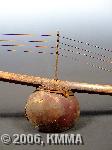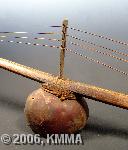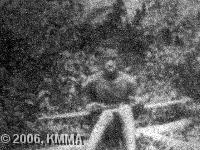


The harp zither is a rare musical instrument in the Congo. Just as its name might suggest, the zither is a chordophone with or without a removable soundboard. The zither can be distinguished particularly by its erect bridge where several strings are held and lie flat and perpendicular to the fretboard. The fretboard is sometimes slightly bowed. The strings can be attached in two ways: either the bridge is perforated with holes through which the strings are threaded, or the comb has notches or grooves through which the strings run.
The oldest picture of a harp zither, taken by A. Hutereau in 1911, shows an example that was found in the north of the Congo, the Uele. The photo shows a Bambinga musician playing a bokongo zither, where he lays the instrument on his lap and plucks the strings.
Just as with other string instruments, the harp zither is played to accompany songs on the basis of a bass melody to provide entertainment.
This type of instrument is used in recordings of our sound archives made with the Congolese peoples mentioned hereafter where it appears with the following vernacular names:
Bafili (Bali, Kumu), Bapili (Mbuti), Enanga (Nande), Enzenze (Nande), Esanzo (Mongo), Inanga (Lega, Rundi), Inanga (Kinubi) (Hutu), Kingwandikila (Bembe), Langangu (Mbunda), Lulanga (Shi), Lunzenze (Luba-Kasai), Mafili (Bafili) (Pygmées), Nanga (Banyoro), Nedongu (Mangbetu), Ngombi (Segwirunibia) (Zande), Ngyela (Luba), Nzenze (Bira), Nzenze (zeze) (Lega), Seki (Mombutu), Zeze (Tembo)
© KMMA